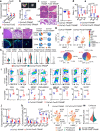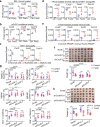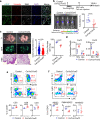Stromal FOXF2 suppresses prostate cancer progression and metastasis by enhancing antitumor immunity
- PMID: 36369237
- PMCID: PMC9652358
- DOI: 10.1038/s41467-022-34665-z
Stromal FOXF2 suppresses prostate cancer progression and metastasis by enhancing antitumor immunity
Abstract
Cancer-associated fibroblasts (CAFs) mediate an immunosuppressive effect, but the underlying mechanism remains incompletely defined. Here we show that increasing prostatic stromal Foxf2 suppresses the growth and progression of both syngeneic and autochthonous mouse prostate cancer models in an immunocompetent context. Mechanistically, Foxf2 moderately attenuates the CAF phenotype and transcriptionally downregulates Cxcl5, which diminish the immunosuppressive myeloid cells and enhance T cell cytotoxicity. Increasing prostatic stromal Foxf2 sensitizes prostate cancer to the immune checkpoint blockade therapies. Augmenting lung stromal Foxf2 also mediates an immunosuppressive milieu and inhibits lung colonization of prostate cancer. FOXF2 is expressed higher in the stroma of human transition zone (TZ) than peripheral zone (PZ) prostate. The stromal FOXF2 expression level in primary prostate cancers inversely correlates with the Gleason grade. Our study establishes Foxf2 as a stromal transcription factor modulating the tumor immune microenvironment and potentially explains why cancers are relatively rare and indolent in the TZ prostate.
© 2022. The Author(s).
Conflict of interest statement
The authors declare no competing interests.
Figures







Similar articles
-
The FOXF2 pathway in the human prostate stroma.Prostate. 2009 Oct 1;69(14):1538-47. doi: 10.1002/pros.20996. Prostate. 2009. PMID: 19562724
-
Tumor formation of prostate cancer cells influenced by stromal cells from the transitional or peripheral zones of the normal prostate.Asian J Androl. 2009 Mar;11(2):176-82. doi: 10.1038/aja.2008.33. Epub 2009 Jan 5. Asian J Androl. 2009. PMID: 19122679 Free PMC article.
-
The dual role of FOXF2 in regulation of DNA replication and the epithelial-mesenchymal transition in breast cancer progression.Cell Signal. 2016 Oct;28(10):1502-19. doi: 10.1016/j.cellsig.2016.06.021. Epub 2016 Jul 1. Cell Signal. 2016. PMID: 27377963 Free PMC article.
-
Novel Therapeutic Targets and Biomarkers Associated with Prostate Cancer-Associated Fibroblasts (CAFs).Crit Rev Oncog. 2022;27(1):1-24. doi: 10.1615/CritRevOncog.2022043478. Crit Rev Oncog. 2022. PMID: 35993976 Review.
-
Molecular insights into prostate cancer progression: the missing link of tumor microenvironment.J Urol. 2005 Jan;173(1):10-20. doi: 10.1097/01.ju.0000141582.15218.10. J Urol. 2005. PMID: 15592017 Review.
Cited by
-
Role of the Forkhead box family protein FOXF2 in the progression of solid tumor: systematic review.J Cancer Res Clin Oncol. 2024 Dec 26;151(1):14. doi: 10.1007/s00432-024-06047-z. J Cancer Res Clin Oncol. 2024. PMID: 39724282 Free PMC article.
-
ATAD2 Drives Prostate Cancer Progression to Metastasis.Mol Cancer Res. 2025 May 2;23(5):379-390. doi: 10.1158/1541-7786.MCR-24-0544. Mol Cancer Res. 2025. PMID: 39907729
-
Cancer-associated fibroblast exosomes promote prostate cancer metastasis through miR-500a-3p/FBXW7/HSF1 axis under hypoxic microenvironment.Cancer Gene Ther. 2024 May;31(5):698-709. doi: 10.1038/s41417-024-00742-2. Epub 2024 Feb 14. Cancer Gene Ther. 2024. PMID: 38351137
-
Molecular panorama of therapy resistance in prostate cancer: a pre-clinical and bioinformatics analysis for clinical translation.Cancer Metastasis Rev. 2024 Mar;43(1):229-260. doi: 10.1007/s10555-024-10168-9. Epub 2024 Feb 19. Cancer Metastasis Rev. 2024. PMID: 38374496 Review.
-
Transdifferentiation of tongue muscle cells into cancer-associated fibroblasts in response to tongue squamous cell carcinoma.Nat Commun. 2025 Jul 22;16(1):6753. doi: 10.1038/s41467-025-61951-3. Nat Commun. 2025. PMID: 40695868 Free PMC article.
References
-
- Wellenstein MD, de Visser KE. CanceR-cell-intrinsic mechanisms shaping the tumor immune landscape. Immunity. 2018;48:399–416. - PubMed
-
- Mhaidly R, Mechta-Grigoriou F. Fibroblast heterogeneity in tumor micro-environment: Role in immunosuppression and new therapies. Semin. Immunol. 2020;48:101417. - PubMed
Publication types
MeSH terms
Substances
Grants and funding
LinkOut - more resources
Full Text Sources
Medical
Molecular Biology Databases

